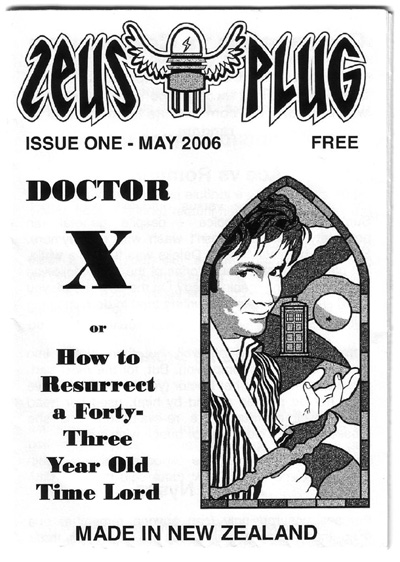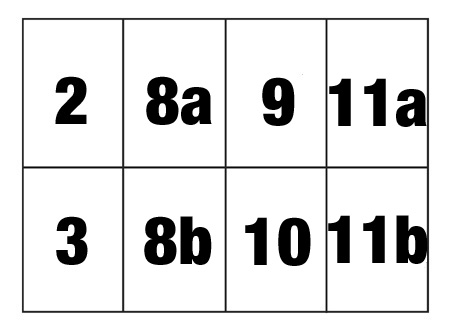Zeus Plug flashback: issue one
Monday, November 18th, 2013To mark November being Tennant month, here’s a return to Zeus Plug‘s debut, and a Tenth Doctor focus straight outta The Christmas Invasion. Oh, we were all so optimistic back then, weren’t we? Feel that youthful hope…
X the Unknown
 In the year 2000 BBC Books, saddled with a Doctor four years into his tenure and carrying a history about him like a tortoise does a shell, took a drastic measure. It made the Eighth Doctor forget who he was, not just for one story, but for a year. Eschewing his companions, temporal knowledge and TARDIS, and for nearly a hundred human years experienced the world and his environment fresh and unaided. This wasn’t the first time such a thing had been done of course – Virgin Books had done a similar thing with the Seventh Doctor in Paul Cornell’s Human Nature; but that story, like every story before it and the ‘Caught on Earth’ cycle, returned the Doctor to his present history-steeped, continuity sodden ‘familiar self’. Of course, what Richards needed, most likely wanted to do that no story before had been able to do, and what he could never hope to achieve, was not making the Doctor forget who he was, but his audience.
In the year 2000 BBC Books, saddled with a Doctor four years into his tenure and carrying a history about him like a tortoise does a shell, took a drastic measure. It made the Eighth Doctor forget who he was, not just for one story, but for a year. Eschewing his companions, temporal knowledge and TARDIS, and for nearly a hundred human years experienced the world and his environment fresh and unaided. This wasn’t the first time such a thing had been done of course – Virgin Books had done a similar thing with the Seventh Doctor in Paul Cornell’s Human Nature; but that story, like every story before it and the ‘Caught on Earth’ cycle, returned the Doctor to his present history-steeped, continuity sodden ‘familiar self’. Of course, what Richards needed, most likely wanted to do that no story before had been able to do, and what he could never hope to achieve, was not making the Doctor forget who he was, but his audience.
Five years later the idea would seem moot, because now most sensibly, Doctor Who is made for a new audience, not a curmudgeonly and shrinking fan base tied to the old series and its continuity. Played from the outset very smartly, with few instances of a ‘restart’ button having been pressed, and (thankfully) no strange desires to make the Doctor half-human, the Eccleston series has been a smash hit. The issue at the end of his supposed first season? The short televised life of the Ninth Doctor, gazumphed in a BBC plot (sort of).
With that in mind, and the how’s return neatly assured, the real gambit would surely be the first regeneration – hardly the surprise that it was in 1966, but still an effective show changer. The Tenth Doctor, therefore, is RTD’s newest gamble, and The Christmas Invasion saw him arrive in style. David Tennant – young actor, a board-treader recently tested with some RTD-produced top shelf BBC fare. But what of the new Doctor himself? The Christmas Invasion, whatever individual fans may review it as, is a master-stroke, and it’s all in the imagery. Blood, shades of the occult, lots of shouting and visceral reds courtesy of the Sycorax, tribal paraphernalia recalling some aspects of the Lord of the Rings movies, and then there’s the Doctor himself. It may well be that in this story the quintessential image of Tennant’s Doctor – of any Doctor for the new century, has been achieved.
And this may be a scary thought if we’ve peaked this early. Nevertheless, can there be a more Doctorish image than that of our hero wielding a sword high above London in his pyjamas? It’s both sublime and ridiculous, projecting bravado and peril as well as delivering a knowing nod to the British tele-fantasy heroes of old as well as those more recent – Arthur Dent’s dressing gown, Harry Potter’s sword. It’s also a neat reflection of Davison’s Doctor’s first moments in Castrovalva; incapacitated, rendered all but useless while some greater peril gathers strength about him. In all its vulnerability its also a symbol of confidence – the polar opposite of Tennant’s predecessor with his tough leather-clad and cropped hair exterior but soft, guilt-ridden centre.
Indeed, if rumour is to be believed, that this season’s theme is of the new Doctor’s over-extended confidence and perilous self-assuredness, then its initial story neatly galvanises both ideas – of the handing down of some very British hero archetypes with an internal motif being developed. What to make of the Satsuma? Is it the ‘Torchwood’ of the new series, appearing as it does in two stories to date (if you care to include Attack of the Graske)? Probably not.
PA


 The earliest association between the Doctor and acts of violence may well occur in An Unearthly Child where, notoriously, the first Doctor contemplates using a rock to euthanise a mortally-wounded caveman. Though he is ultimately interrupted, there is still something shocking to the scene; but not so much that the Doctor intends to kill a dying man, it’s that he sees it as an option. The Doctor Who universe has always been a dangerous place, and scarcely ten years after this scene the perils of his livelihood became a lot more visceral on-screen. ‘Body horror’ featured on a semi regular basis as a motif during the Philip Hinchcliffe-produced stories of the early Tom Baker years, as the tortuous effects of bodily transformation, mutation, and alien possession all formed part of the spectacle. Protests by Mary Whitehouse’s National Viewers’ and Listeners’ Association led much of the outright violence in Doctor Who to be curtailed, but it crept back – why? And why in the era of a Doctor whom many fans might consider the least aggressive of all, Peter Davison’s fifth Doctor?
The earliest association between the Doctor and acts of violence may well occur in An Unearthly Child where, notoriously, the first Doctor contemplates using a rock to euthanise a mortally-wounded caveman. Though he is ultimately interrupted, there is still something shocking to the scene; but not so much that the Doctor intends to kill a dying man, it’s that he sees it as an option. The Doctor Who universe has always been a dangerous place, and scarcely ten years after this scene the perils of his livelihood became a lot more visceral on-screen. ‘Body horror’ featured on a semi regular basis as a motif during the Philip Hinchcliffe-produced stories of the early Tom Baker years, as the tortuous effects of bodily transformation, mutation, and alien possession all formed part of the spectacle. Protests by Mary Whitehouse’s National Viewers’ and Listeners’ Association led much of the outright violence in Doctor Who to be curtailed, but it crept back – why? And why in the era of a Doctor whom many fans might consider the least aggressive of all, Peter Davison’s fifth Doctor?

 Armed with Radio Times reference and a doodle boasting more character than my finished illustration would, I was sent off to suck the ink clots out of my drawing pens and put a quiff on top of Tennant’s Casanova face. As well as a peerless artist and cartoonist, Peter is an imaginative Art Director, and suggested the stained glass window approach. I forget why, but like Jack Sparrow’s walk or ‘V’s Betty Boop wig, this piece of inspired randomness somehow worked – particularly with the colour version which he published on-line. Intoxicated with being involved in something new and potentially exciting, I was happy to tackle Tennant’s likeness (although these new-fangled young Doctors lack the inspiring facial crags and crevasses of their predecessors), and depict what is still my favourite Christmas special.
Armed with Radio Times reference and a doodle boasting more character than my finished illustration would, I was sent off to suck the ink clots out of my drawing pens and put a quiff on top of Tennant’s Casanova face. As well as a peerless artist and cartoonist, Peter is an imaginative Art Director, and suggested the stained glass window approach. I forget why, but like Jack Sparrow’s walk or ‘V’s Betty Boop wig, this piece of inspired randomness somehow worked – particularly with the colour version which he published on-line. Intoxicated with being involved in something new and potentially exciting, I was happy to tackle Tennant’s likeness (although these new-fangled young Doctors lack the inspiring facial crags and crevasses of their predecessors), and depict what is still my favourite Christmas special.  Update: Here’s the final cover, scanned as Jono requested. I didn’t want to include this in case the other details detracted from the topic at hand. But it’s probably the best place for it at the moment!
Update: Here’s the final cover, scanned as Jono requested. I didn’t want to include this in case the other details detracted from the topic at hand. But it’s probably the best place for it at the moment!

 We’ve never seen an actual zeus plug in the TV series of course, though they’ve been described. One story has them as huge things, but the assumption is something a little more portable, something you could carry around idly in your pocket. Like the zine. Pluggy combines the elements I thought the zine’s title needed – he is a plug (specifically a NZ three-point plug), and he has a lightning bolt inside his bulb, both to refer to the God of Lightning and to signify that the radiant bulb of inspiration was definitely ‘on’. There’s a deliberate retro look to Pluggy – he’s not a USB key for one, and his bulb is most definitely a radiant filament job. Around his mid-section are discs from a Dalek eyestalk, and he has a six-sided nut for a bum, recalling the hexagonal roundels of the [then] new TARDIS console interior. His first incarnation had wings for speed, and the current one on this blog gives him a ring of confidence with that lightning bolt returning. There’s another version of him with arms – a further nod to the other inspiration of his design, the
We’ve never seen an actual zeus plug in the TV series of course, though they’ve been described. One story has them as huge things, but the assumption is something a little more portable, something you could carry around idly in your pocket. Like the zine. Pluggy combines the elements I thought the zine’s title needed – he is a plug (specifically a NZ three-point plug), and he has a lightning bolt inside his bulb, both to refer to the God of Lightning and to signify that the radiant bulb of inspiration was definitely ‘on’. There’s a deliberate retro look to Pluggy – he’s not a USB key for one, and his bulb is most definitely a radiant filament job. Around his mid-section are discs from a Dalek eyestalk, and he has a six-sided nut for a bum, recalling the hexagonal roundels of the [then] new TARDIS console interior. His first incarnation had wings for speed, and the current one on this blog gives him a ring of confidence with that lightning bolt returning. There’s another version of him with arms – a further nod to the other inspiration of his design, the 
 And Dave also pitched in. Dave wanted his to open intuitively like a map or schematic, which maybe spoke more of his engineering background. Nobody thought the regular folds and creases of the page needed to act as article borders, but it helped in places.
And Dave also pitched in. Dave wanted his to open intuitively like a map or schematic, which maybe spoke more of his engineering background. Nobody thought the regular folds and creases of the page needed to act as article borders, but it helped in places.
 And last of all, mine, which won through some democratic action snuggled up with some good old-fashioned autocratic foot stomping. I wanted mine to open like a flower. My idea was to have a folded page that opened like a book, turned itself over and continued to read like a book, then opened out to be a larger piece of paper – one side of the A3 page with which you could do anything. It could be a poster, a flow diagram, a game board, wrapping paper… in other words, it could take a step to the side and be something other than a fanzine. I don’t know if I seriously took that idea to the table with Jono though, I think we just had too much to say, and filled the space available. BAZ is closer to that ideal.
And last of all, mine, which won through some democratic action snuggled up with some good old-fashioned autocratic foot stomping. I wanted mine to open like a flower. My idea was to have a folded page that opened like a book, turned itself over and continued to read like a book, then opened out to be a larger piece of paper – one side of the A3 page with which you could do anything. It could be a poster, a flow diagram, a game board, wrapping paper… in other words, it could take a step to the side and be something other than a fanzine. I don’t know if I seriously took that idea to the table with Jono though, I think we just had too much to say, and filled the space available. BAZ is closer to that ideal.

 Part Two: The Pitch
Part Two: The Pitch